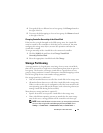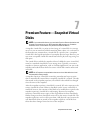
68 Snapshot Virtual Disks
When you create a snapshot virtual disk, you specify where to create the
snapshot repository virtual disk, its capacity, and other parameters. You can
disable or delete the snapshot virtual disk when you no longer need it, such as
when the backup is complete. If you disable a snapshot virtual disk, you can
re-create and reuse it the next time you perform a backup (see "Re-creating
Snapshot Virtual Disks" on page 80 for more information). If you delete a
snapshot virtual disk, you also delete the associated snapshot repository
virtual disk.
NOTE: Deleting a snapshot does not affect data on the source virtual disk.
The information that follows will better prepare users for using the snapshot
virtual disk premium feature of the Dell PowerVault systems.
NOTE: The following host preparation sections also apply when using the snapshot
feature through the CLI interface.
Creating a Snapshot Virtual Disk Using the
Simple Path
You can choose the simple path to create a snapshot virtual disk if the disk
group of the source virtual disk has the required amount of free space. A
snapshot repository virtual disk requires a minimum 8 MB of free capacity.
The destination of a snapshot repository virtual disk is determined based on
the free capacity available in the disk group.
If 8 MB of free capacity is not available in the disk group of the source virtual
disk, the Create Snapshot Virtual Disks feature defaults to the advanced
path (see "Creating a Snapshot Virtual Disk Using the Advanced Path" on
page 73). In the advanced path option, you can choose to place the snapshot
repository virtual disk in another disk group or you can use unconfigured
capacity on the storage array to create a new disk group.
About the Simple Path
Using the simple path, you can specify the following parameters for your
snapshot virtual disk:
•
Snapshot Virtual Disk Name
— A user-specified name that helps you
associate the snapshot virtual disk to its corresponding snapshot repository
virtual disk and source virtual disk.


















